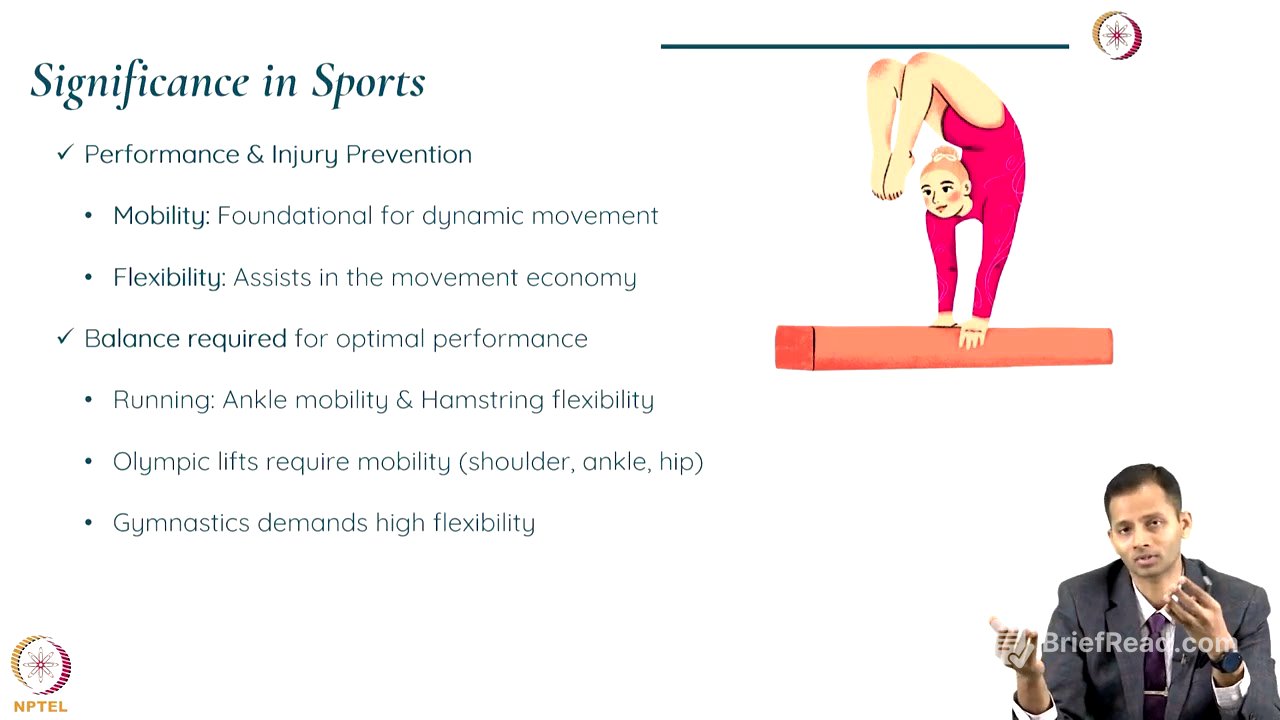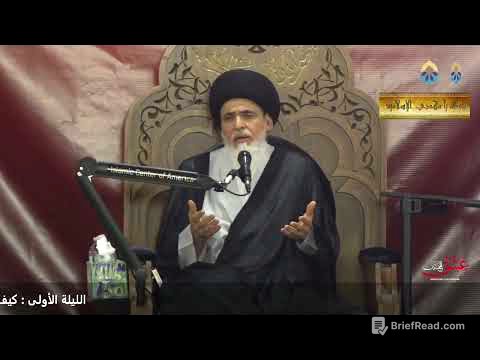TLDR;
This lecture distinguishes between joint mobility and flexibility, explaining their importance in sports, the factors influencing them, and training methods to improve them. It emphasizes that while distinct, both are crucial for athletic performance, injury prevention, and rehabilitation. The lecture also covers assessment techniques, practical applications through a case scenario, and considerations for age, gender, and rehabilitation phases.
- Mobility is joint-focused and involves active control, while flexibility is muscle-focused with passive potential.
- Both mobility and flexibility are essential for injury prevention and performance enhancement in sports.
- Training programs should be individualized, considering age, gender, and the phase of rehabilitation.
Introduction: Naman's Case and Learning Objectives [0:15]
The lecture begins by introducing Naman, a long-distance runner experiencing stiffness, to illustrate the importance of understanding mobility and flexibility. The learning objectives include defining flexibility and mobility, differentiating them, understanding their significance in sports, identifying influencing factors, and exploring training methods to improve them. Practical aspects are discussed using Naman's case as a scenario.
Importance of Mobility and Flexibility [1:42]
Mobility and flexibility are integral to athletic performance and injury prevention. These terms are often confused, but they represent distinct concepts with differences that depend on the biomechanical, physiological, and neuromuscular demands of specific sports.
Defining Joint Mobility and Flexibility [2:17]
Joint mobility is the capacity of a joint to move actively through a range of motion, depending on joint structure, soft tissues, and neuromuscular control. Flexibility is the ability of a muscle or muscle groups to lengthen, influenced by muscle-tendon properties and the extensibility of connective tissue. Mobility is joint-focused with active control, while flexibility is muscle-focused with passive potential. Mobility is a broader entity encompassing flexibility.
Anatomical and Neuromuscular Influences [3:28]
Bones, ligaments, and the joint capsule influence mobility, while muscle length, fascia, and connective tissues affect flexibility. The nervous system controls these anatomical factors. Neuromuscular control involves a brain-body connection where mobility is restricted to motor control, emphasizing proprioception and reflexes. Flexibility involves activating the neuromuscular component by sensing changes in length or force development.
Assessing Mobility and Flexibility [4:44]
Mobility can be assessed using functional movement screens, which rate movement patterns objectively, and goniometers, which measure joint-specific range of motion in an angular manner. There are two types of mobility: active and passive. Flexibility can be tested using the sit and reach test for overall flexibility and the straight leg raise for hamstring flexibility. Muscle length tests can also assess the flexibility of specific joints.
Significance in Sports [7:38]
Both flexibility and mobility are useful in performance and injury prevention. Mobility is foundational for dynamic movement and improving performance, while flexibility assists in movement economy by ensuring optimal muscle length for force production. Balance, a component of mobility, is also required for optimal performance. In running, excessive ankle mobility can cause compensatory movements at the knee and hip, impairing movement efficiency. Similarly, hamstring flexibility is crucial for runners. Sports like Olympic lifting require mobility at major joints, while gymnastics relies more on flexibility.
Case Scenario: Naman the Long-Distance Runner [10:03]
Naman, the long-distance runner, experiences stiffness in his lower back and right thigh. Assessing him involves checking hamstring flexibility with a straight leg raise test. Hamstring tightness is common in long-distance runners due to increased load and cyclical movements. Recommendations include proper warm-up and cool-down sessions with static stretching of major muscle groups like hamstrings, hip flexors, quadriceps, and calf muscles. PNF stretching techniques can also be implemented for individuals with previous injuries to maintain balance between limbs.
Factors Influencing Mobility and Flexibility [11:54]
Factors influencing mobility include joint structure, soft tissues around the joint, motor control, and pain. Pathological joint problems, overuse injuries, and soft tissue injuries or inflammation can affect mobility. Post-injury, proprioception, coordination, and balance are affected, necessitating mobility drills in sports rehabilitation. Pain can cause compensatory muscle inhibition, affecting mobility. Flexibility is mainly affected by muscle and connective tissue factors, such as muscle viscosity, connective tissue stiffness, neural tension, and temperature.
Training for Mobility and Flexibility [15:46]
Mobility training includes dynamic mobility drills during warm-up, controlled articular rotations, mobilization with movement, and resistance training through a full range of motion. Flexibility can be improved through static stretching in cool-down routines, PNF techniques, and dynamic stretching in warm-up sessions. Ballistic stretching can be used in specific warm-up protocols.
Age and Gender Considerations [17:28]
Age affects flexibility, with stiffness increasing in connective tissues with age. Young athletes may be more flexible but have less control, requiring dynamic stretching training. Older adults benefit from static stretching techniques. Gender differences, due to hormonal factors, make females generally more flexible, but they may also have a higher propensity for joint instability, requiring appropriate stability exercises.
Mobility and Flexibility in Rehabilitation [18:55]
In rehabilitation, prioritization depends on the phase of rehab and tissue healing. Phase one focuses on achieving movement control and a minimum required range of motion. Phase two focuses on reaching a full range of motion and resistance activities. Early phases emphasize mobility, while later phases focus on flexibility and controlled resistance training.
Integration into Sports Training Programs [20:21]
Integrating mobility and flexibility programs into sports training is integral for injury prevention. Mobility exercises can be combined in warm-ups, and sport-specific movements can be used for neuromuscular facilitation. Individualizing corrective exercises based on assessments of flexibility and mobility is crucial, incorporating dynamic exercises in pre-session warm-ups and static exercises in post-session cool-down routines.
Summary [21:45]
Mobility and flexibility are distinct but complementary, essential for injury prevention and performance. Individualized training is critical. Flexibility can be improved by static and PNF stretches, while mobility can be addressed by dynamic stretches and movement drills in warm-up sessions. Lack of flexibility and mobility may cause biomechanical alterations and compensations, requiring attention when framing training programs.









